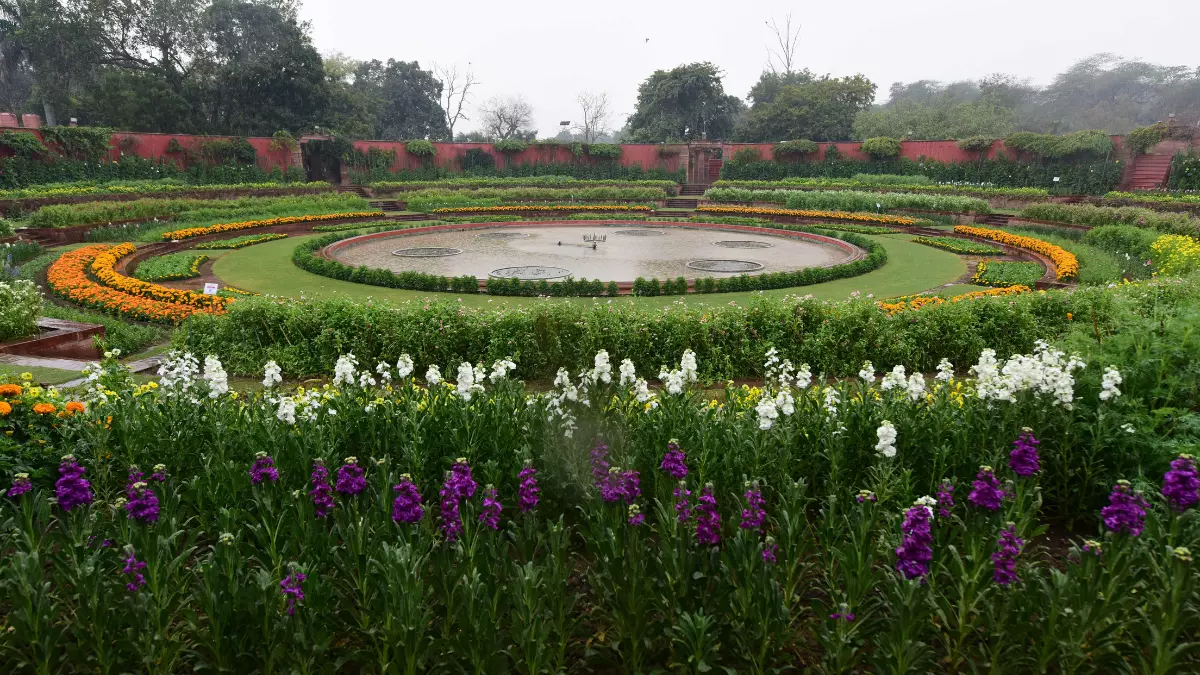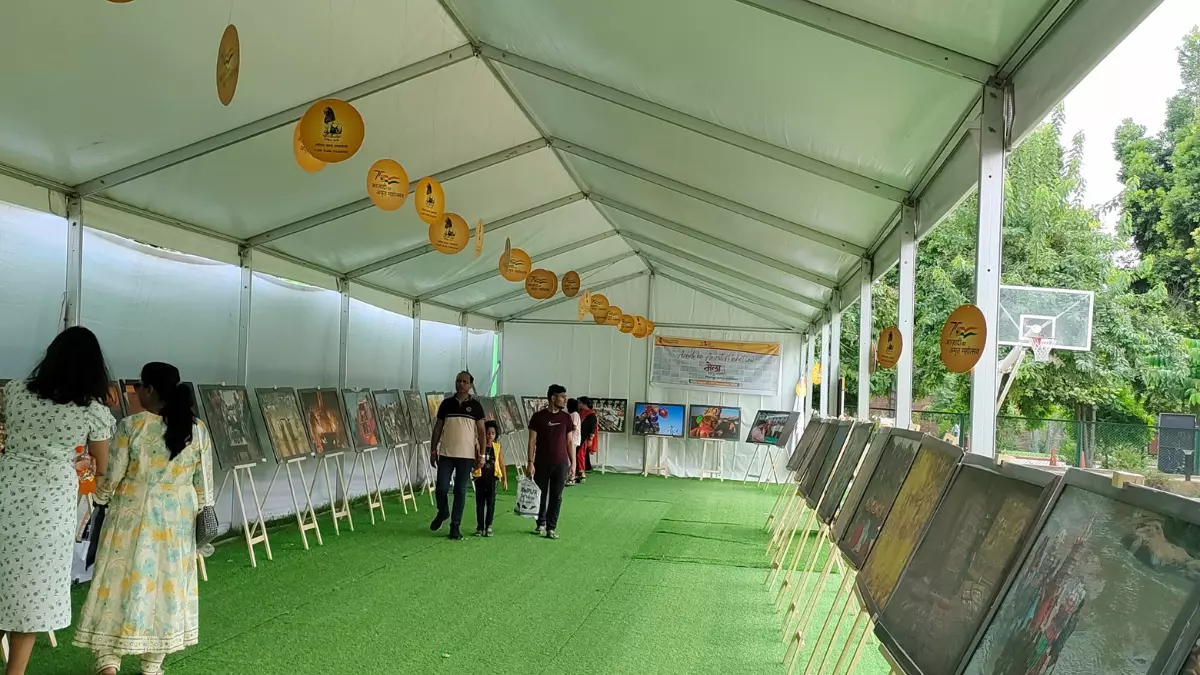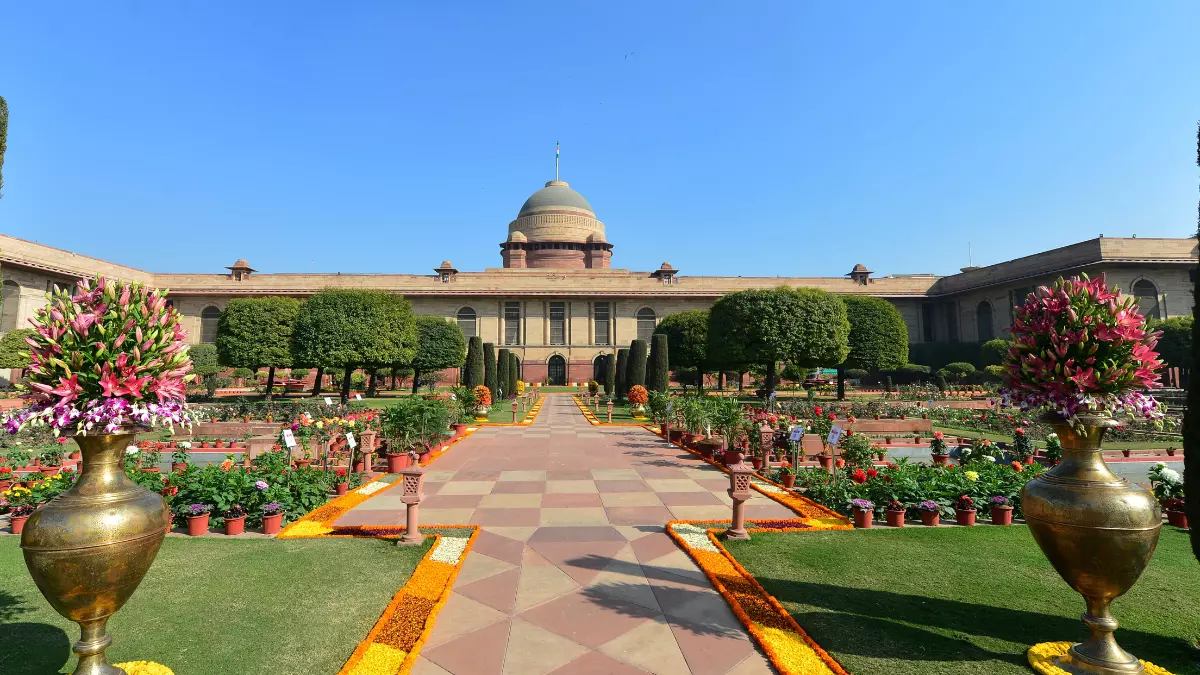Have you ever wondered what it’s like to step into the heart of India’s democracy, where history, architecture, and nature beautifully intertwine? Picture a place where the very essence of the nation’s values— democracy, strength, and secularism–are not just celebrated but lived every day. Rashtrapati Bhavan, with its grand architecture and sprawling gardens, offers more than just a glimpse into the President’s residence; it invites you to explore the rich tapestry of India’s heritage. This iconic site has become even more captivating after its renaming to Amrit Udyan by President Draupadi Murmu on January 28. What secrets and stories might you uncover as you walk through its elegant corridors and lush greenery? Let’s embark on a journey that promises to reveal the very soul of India’s democratic spirit.
Brief overview of the significance of Amrit Udyan and the Rashtrapati Bhavan Museum

About Rashtrapati Bhawan –
Rashtrapati Bhavan, the official residence of the President of India, stands as a monumental symbol of the nation’s democratic values and rich cultural heritage. This architectural masterpiece, designed by the renowned British architect Sir Edwin Lutyens, seamlessly blends classical European architecture with Indian design elements, creating a grand and deeply rooted structure in the country’s traditions. The building’s red and cream sandstone façade, adorned with intricate Mughal and Rajasthani motifs, and the central dome inspired by the ancient Sanchi Stupa, exemplify this unique fusion.
Spread over a vast 320 acres, Rashtrapati Bhavan is not only a residence but also a testament to India’s journey from a colonial past to a vibrant democracy. The estate includes 340 rooms, among them the majestic Durbar Hall, which has witnessed numerous historic events, including the swearing-in of presidents and other significant ceremonies. The grandeur of Rashtrapati Bhavan reflects the strength and resilience of India’s democratic institutions.
Significance of Amrit Udyan

Amrit Udyan, formerly known as the Mughal Gardens, is often regarded as the soul of Rashtrapati Bhavan. This stunning landscape, covering 15 acres within the presidential estate, is a masterpiece of garden design that draws inspiration from the traditional Mughal gardens, known for their symmetry, fountains, and vibrant floral displays. Amrit Udyan was renamed on January 28, 2023, by President Draupadi Murmu, further enhancing its significance as a symbol of renewal and continuity in India’s cultural heritage.
The gardens are divided into several sections, each with its own unique charm. Initially, the garden comprised the East Lawn, Central Lawn, Long Garden, and Circular Garden. Over time, it expanded to include new gardens such as Herbal-I, Herbal-II, Tactile Garden, Bonsai Garden, and Arogya Vanam, developed during the tenures of former Presidents Dr. A.P.J. Abdul Kalam and Shri Ram Nath Kovind. These gardens not only provide a tranquil escape in the heart of the bustling capital but also showcase the diverse flora of India, including rare herbs, bonsai trees, and medicinal plants.
Significance of Rashtra Ka Bhavan Museum
The Rashtra Ka Bhavan museum, located within the Rashtrapati Bhavan estate, offers visitors a deep and insightful exploration of the history and legacy of the Indian presidency. The museum is a treasure trove of rare artifacts, artworks, and historical documents that chronicle the journey of India’s leaders and the evolution of its democratic institutions. Through its exhibits, the museum tells the story of India’s transformation from a colonial state to an independent, democratic nation, highlighting the pivotal role played by the President in this ongoing narrative.
The museum’s significance lies in its ability to connect visitors with the rich history of India’s leadership and governance. It serves as an educational resource, providing a glimpse into the lives and contributions of the country’s presidents, as well as a reflection on the broader historical events that have shaped modern India
Amrit Udyan and Rashtrapati Bhavan Museum: Now Open for Public

From 16th August to 15th September 2024, Amrit Udyan invites the public to explore its breathtaking summer annuals. Visitors can enjoy the vibrant colours of seasonal flowers like Coleus, Celosia, and Tuberose, along with newly designed landscapes and special setups that promise a captivating experience. Additionally, the Rashtrapati Bhavan Museum offers an enriching journey through India’s presidential history, showcasing rare artefacts and exhibits that reflect the nation’s democratic heritage
What’s New at Amrit Udyan: A Peek into the Latest Attractions

- Bal Vatika: A newly designed children’s garden featuring a 225-year-old Sheesham tree, a treehouse, and a Nature classroom, providing an engaging space for young visitors.
- Eco-Friendly Memento: Visitors will receive a Seed Paper memento, an eco-friendly initiative to encourage creating and nurturing green spaces at home. The Seed Paper is infused with seeds, allowing visitors to plant and grow their own greenery.
- Bonsai and Circular Gardens: Avneesh Banswal, the horticulturist at Rashtrapati Bhavan, highlights these gardens for their diverse flora and fauna. Special attention is given to the maintenance of these plants during the challenging summer months.
- Stone Abacus: A unique stone abacus has been installed, offering an interactive learning experience where children can explore numbers and mathematical concepts while connecting with nature.
- Sound Pipe: An interactive sound pipe exhibit will allow children to experience acoustics in a fun way. Voices spoken into one end travel through the pipe and emerge clearly at the other, even across the park.
- Music Wall: A vibrant new Music Wall made from recycled materials invites children to explore their creativity and musical talents through hands-on interaction with a variety of instruments
Vividhta Ka Amrit Mahotsav: A Southern Cultural Festival

Get ready for the second edition of Vividhta Ka Amrit Mahotsav, happening from September 12th to 15th, 2024, at Rashtrapati Bhavan! This exciting four-day event will run daily from 10 AM to 8 PM, bringing the vibrant cultures of Southern India right to you. Dive into the rich traditions of Andhra Pradesh, Karnataka, Telangana, Kerala, and Tamil Nadu, along with Puducherry, Andaman & Nicobar Islands, and Lakshadweep. The festival will feature a lively handicrafts fair, mesmerizing cultural performances, art exhibitions, interactive workshops, a Book Fair, and a special north-eastern food festival. With so much to see and do, it’s a fantastic way to explore Southern India’s diverse and colourful heritage!
Rashtrapati Bhavan Museum: Explore India’s Rich Presidential History

The Rashtrapati Bhavan Museum is one of the most admired museums in Delhi. Located within the grounds of Rashtrapati Bhavan, it was inaugurated in 2014 by then-President Pranab Mukherjee. The museum showcases priceless artefacts and beautiful items for those who love art, culture, and history. It is part of Circuit 2 in the complex and is divided into three sections: The Clock Tower, The Stables, and The Garage, with The Garage being the latest addition, opened in 2016.
Built at a cost of over ₹80 crores in just two years, the underground museum holds valuable gifts received by India from around the world since the time of our first President, Dr. Rajendra Prasad. The museum also uses virtual reality equipment and multi-screen displays to bring stories to life. In addition to displaying artefacts, it has an art gallery that frequently hosts exhibitions and a platform where you can listen to speeches from former Presidents of India. Overall, the museum is a remarkable place and definitely worth a visit
Must-See Highlights of the Rashtrapati Bhavan Museum
This season, make your way to Amrit Udyan and the Rashtrapati Bhavan Museum for an unforgettable experience. Amrit Udyan will be a floral extravaganza, transformed into a vibrant tapestry of seasonal blooms. With the garden adorned in a dazzling array of flowers, including Coleus, Celosia, and Tuberose, it promises to be a veritable cornucopia of colour and fragrance. The addition of new features like the interactive Stone Abacus and the Sound Pipe will make your visit even more engaging, blending nature with educational fun.
Adding to the allure is the Vividhta Ka Mahotsav, a special event running from September 12th to 15th. This celebration will showcase the rich cultural heritage of Southern India, offering a unique opportunity to experience the region’s traditions and arts in the heart of New Delhi. At the Rashtrapati Bhavan Museum, explore the latest addition—the Garage, which houses an impressive collection of historical vehicles and artefacts. With its blend of vibrant gardens and enriching museum exhibits, this season promises a captivating journey through India’s heritage and creativity.
Plan Your Visit: Essential Information for Amrit Udyan and Rashtrapati Bhavan Museum

Opening Dates and Hours:
- Dates: August 16th to September 15th, 2024 (Closed on Mondays)
- Hours: 10:00 AM to 6:00 PM (Last entry at 5:15 PM)
- Entry Gate: Gate No. 35 of Rashtrapati Bhavan, near North Avenue
Special Days:
- August 29th: Exclusive access for sportspersons
- September 5th: Exclusive access for teachers
Vividhta Ka Amrit Mahotsav:
- Dates: September 12th to 15th, 2024
- Event: Celebrate the cultural richness and traditions of Southern India
Entry Fees and Booking Information:
- Fee: ₹50 per visitor per circuit, payable online. Non-refundable and non-transferable. Visitors below 8 years old are exempt from charges.
- Booking: Tickets can be purchased online at the Rashtrapati Bhavan’s official site under the “Amrit Udyan” section or at the entry gate.
How to Book Your Visit to Amrit Udyan:

- Visit the Official Website: Go to the Rashtrapati Bhavan’s official site.
- Find Amrit Udyan: Click on the “Amrit Udyan” tab and choose “Book Your Visit Now.”
- Choose Date and Time: Pick your desired date and time, then click ‘Continue.’
- Provide Visitor Details: Enter the number of people in each age group and provide a mobile number for OTP verification.
- Review and Confirm: Check the OTP and review your booking details.
- Download and Print Your Ticket: Save, download, and print your ticket for your visit.
Important Information:
- Entry: Through Gate No. 35, Rashtrapati Bhavan.
- Parking: Free parking is available on North Avenue Road.
- Shuttle Service: Free shuttle bus from Central Secretariat Metro Station.
- Allowed Items: Water bottles, umbrellas, wallets, purses, and milk bottles for babies.
- Prohibited Items: No entry for stables, paan, gutka, cigarettes, backpacks, cameras, video cameras, or laptops.
- Food and Beverages: Available for purchase at the food court.
Enjoy your visit to Amrit Udyan and the Rashtrapati Bhavan Museum
How to Reach Amrit Udyan, Rashtrapati Bhavan?

By Train
- New Delhi Railway Station: 4.4 km from Rashtrapati Bhavan.
- Nizamuddin Railway Station: 9.4 km away.
- Old Delhi Railway Station: 9.5 km away.
By Road
- Entry Point: Amrit Udyan can be accessed through Gate No. 35, located 2.7 km from Connaught Place, one of Delhi’s major commercial hubs.
By Bus
- RML Hospital: 0.8 km away.
- Gurudwara Rakabganj: 0.7 km away.
- Kendriya Terminal: 1.1 km away.
- Krishi Bhawan/Central Secretariat Gate No. 2: 2.0 km away.
By Metro
- Central Secretariat Metro Station: 2.0 km away, with a free shuttle service available from Gate No. 4 of the station to Amrit Udyan.
- Shivaji Stadium Metro Station: 2.0 km away.
These various transportation options make reaching Amrit Udyan convenient, whether you’re coming by train, road, bus, or metro. The free shuttle service from the Central Secretariat Metro Station adds an extra layer of convenience for visitors.
Amrit Udyan offers a multitude of attractions for visitors, each adding to the garden’s charm:

1. Sheesham Tree
One of the oldest and most revered trees in the Amrit Udyan, this 225-year-old Sheesham tree stands as a living testament to nature’s endurance and the historical depth of Rashtrapati Bhavan. Its sprawling branches provide shade and serenity, making it a key attraction in the garden. The tree is a focal point of the Bal Vatika, where its story is intertwined with the theme of nature’s classroom, offering visitors a moment of reflection amidst its ancient roots.
2. Bonsai Garden
The Bonsai Garden at Amrit Udyan is a delicate collection of miniature trees, meticulously crafted and nurtured to mirror the grandeur of their full-sized counterparts. Each bonsai tree represents a blend of art and horticulture, symbolizing patience, precision, and the beauty of nature in miniature form. This garden offers a peaceful retreat, where visitors can appreciate the intricate details and artistry involved in maintaining these living sculptures.
3. Musical Fountain
The Musical Fountain is a captivating spectacle within Amrit Udyan, where water, light, and music come together in a harmonious display. As the fountain’s jets dance to the rhythm of various tunes, visitors are treated to a mesmerizing experience that highlights the garden’s blend of natural beauty and technological innovation. The fountain is especially enchanting in the evening when it becomes a centrepiece of colour and sound, offering a magical ambience to the garden.
4. Haat and Exhibition
The Haat and Exhibition area in Amrit Udyan is a vibrant hub where culture and commerce meet. Here, visitors can explore stalls showcasing traditional Indian crafts, textiles, and local delicacies. The exhibition also features displays of art and historical artefacts related to Rashtrapati Bhavan, providing a rich cultural experience. This area serves as a lively marketplace that celebrates the diversity of India’s artistic heritage, making it a must-visit for those interested in the country’s cultural tapestry.
5. Nature Classroom – Bal Vatika
The Bal Vatika, or Children’s Garden, is a specially curated space within Amrit Udyan designed to educate and inspire young minds. This ‘Nature Classroom’ features interactive elements like a treehouse and storyboards that narrate the tale of the ancient Sheesham tree. The garden encourages children to engage with nature, fostering an appreciation for the environment through hands-on learning experiences. It’s a playful yet educational spot that adds a family-friendly dimension to the Udyan.
6. Central Lawn

The Central Lawn is the heart of Amrit Udyan, a vast expanse of meticulously manicured grass that hosts official functions and ceremonies. Surrounded by vibrant flower beds and framed by the majestic Rashtrapati Bhavan, the lawn is a symbol of India’s governance and hospitality. Visitors can stroll through this open space, taking in the grandeur of the surroundings while enjoying the peaceful ambiance of the garden.
7. Floral Clock
The Floral Clock is a unique attraction within Amrit Udyan, where time and nature blend seamlessly. This large, functional clock is made entirely of flowers and plants, with each season bringing a new burst of colour and design. It serves as a beautiful reminder of the passage of time, set against the backdrop of the garden’s greenery. The Floral Clock is not only a marvel of horticultural design but also a popular photo spot for visitors.
8. Circular Garden
The Circular Garden is a beautifully designed area within Amrit Udyan, featuring concentric rings of flowering plants and shrubs. This garden showcases a diverse variety of flora, arranged in patterns that change with the seasons. The Circular Garden is a testament to the skilful gardening practices at Rashtrapati Bhavan, offering a vibrant and colourful display that captivates visitors with its symmetry and beauty.
9. Floral Signage
Floral Signage in Amrit Udyan adds an artistic touch to the garden’s pathways and open spaces. These signs are creatively crafted using flowering plants and foliage, spelling out names and messages in vibrant colours. The Floral Signage not only enhances the aesthetic appeal of the garden but also serves as a guide, helping visitors navigate through the expansive grounds while enjoying the intricate botanical designs.
10. Vertical Garden
The Vertical Garden at Amrit Udyan is a modern horticultural innovation that adds a dynamic element to the traditional landscape. Comprising walls of greenery that rise vertically, this garden features a variety of plants carefully arranged to create living murals. The Vertical Garden is a testament to the versatility of plant life, demonstrating how nature can be integrated into urban spaces in creative and sustainable ways.
11. Birds of Rashtrapati Bhavan
The lush and diverse gardens of Amrit Udyan are a haven for birdlife, attracting a variety of species that add a lively dimension to the garden’s ecosystem. From vibrant peacocks, the national bird of India, to smaller, colourful songbirds, visitors can enjoy birdwatching in this natural sanctuary. The presence of these birds not only enriches the garden experience but also highlights the importance of preserving natural habitats within urban settings.
A visit to Rashtrapati Bhavan and Amrit Udyan is more than just a glimpse into the official residence of India’s President; it’s an exploration of the nation’s architectural grandeur, historical significance, and natural beauty. As you walk through the opulent halls of Rashtrapati Bhavan and the lush expanses of Amrit Udyan, you’re not just witnessing India’s democratic heart- you’re experiencing the rich tapestry of its cultural heritage and the enduring spirit of its people. Whether you’re marvelling at the intricate designs, learning about the nation’s governance, or simply enjoying the tranquillity of the gardens, this visit offers a profound connection to the essence of India. A trip to this iconic landmark leaves you with a deep sense of pride and a greater appreciation for the history and traditions that continue to shape this vibrant democracy.
where is Rashtrapati Bhavan?
Rashtrapati Bhavan is situated in New Delhi, India’s capital, at the western end of Rajpath, the ceremonial avenue. It is nestled within an extensive estate that features stunning gardens and vast open spaces.
who built Rashtrapati Bhavan?
Rashtrapati Bhavan was designed by British architect Sir Edwin Lutyens. It was built under his supervision and finished in 1929. Initially, it served as the Viceroy’s residence during British rule.
how many rooms are there in Rashtrapati Bhavan?
Rashtrapati Bhavan was designed by British architect Sir Edwin Lutyens. It was built under his supervision and finished in 1929. Initially, it served as the Viceroy’s residence during British rule.


